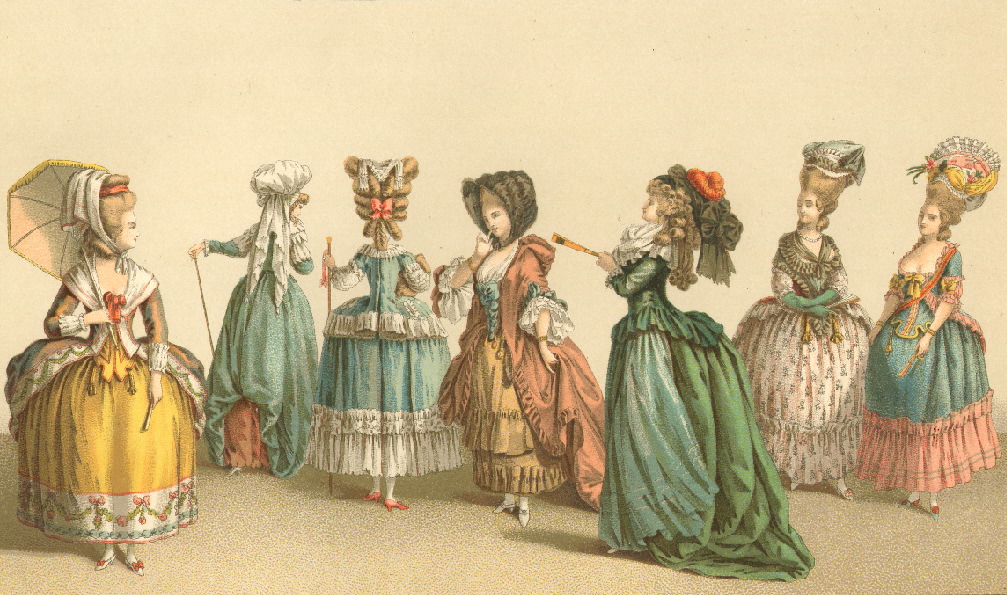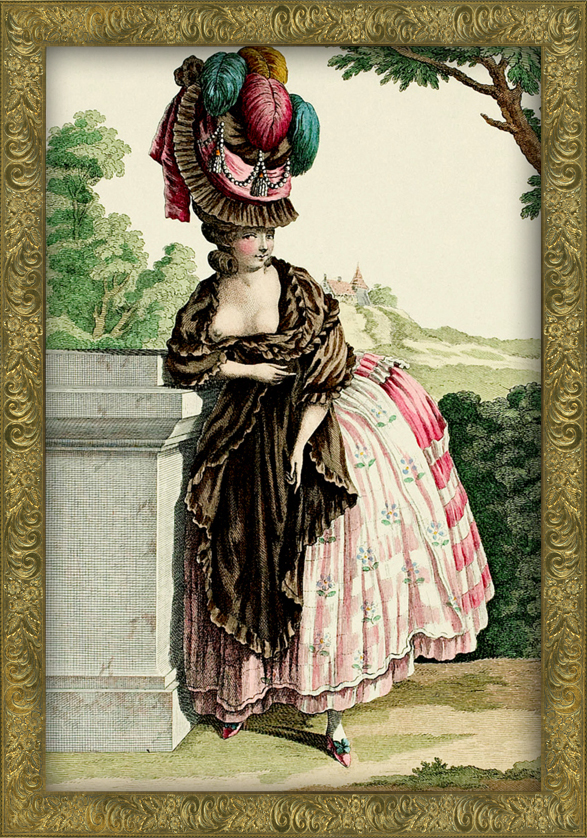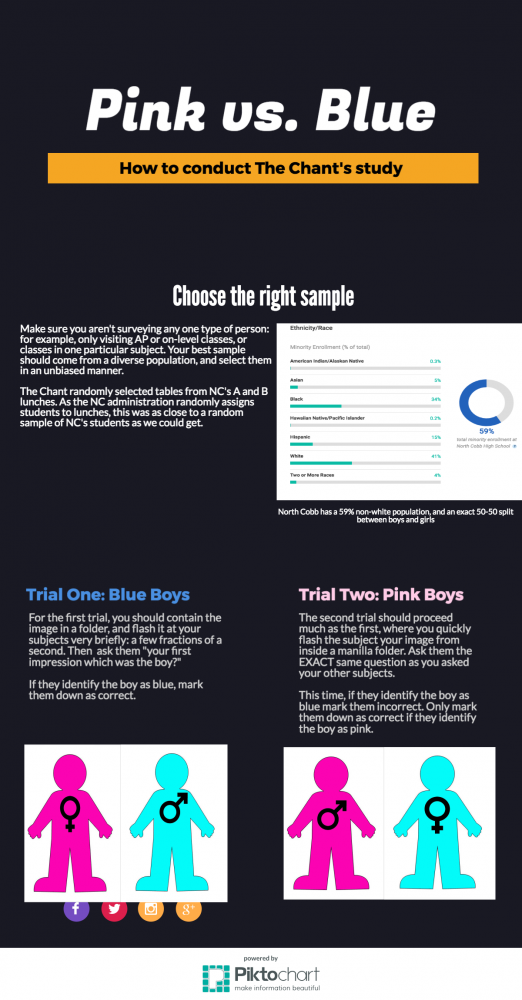Your donation will support the student journalists of North Cobb High School. Your contribution will allow us to purchase equipment and cover our annual website hosting costs.
“A girl in blue? Who knew!”
May 16, 2017
In any WalMart, one can easily pick out the toy section from all the others without even reading the signs: an aisle divided straight down the middle, one side containing blues, blacks, grays, forest greens, and other sober colors, while the other side contains pinks, yellows, baby blues, and all the “bright and happy” colors of the spectrum.
While society segregates other objects and activities by sex for valid reasons — sports because of hormonal and anatomical differences, and restrooms for issues of modesty and safety — color segregation makes little sense and lacks any basis in logic or reason of any kind. After all, while the association of pink with girls and blue with boys may seem so natural to not merit a second thought, a reversal in those color choices, or even a change to two completely different colors, makes no real difference in their function.
So how did society end up with this color choice in all things gender-related? One can most apparently see this color segregation in children’s products because of society’s strange need to codify and reaffirm the gender roles of children, but even after puberty, this distinction persists in the use of pink for breast cancer awareness, while blue stands for prostate cancer, the informal “pink tax” on women’s products, and countless female-targeted pink fashion lines, including the unsubtle “PINK.” by Victoria’s Secret.
As one would probably suspect by the arbitrary nature of this color assignment, it only developed in Western society in the last 100 years. For the vast majority of post-Roman European (and later Colonial American) history, society did not segregate pink and blue as gendered colors, and childcare experts had not yet designated them as “children’s colors.”
Once the colors became connected to children, they changed between which shade represented which gender. As early as 1889, education journals, while discussing how children play, referenced “the blouse worn by all, paying and non-paying — pink for the boys, blue for the girls.” The earliest sources of the opposite color scheme used exclusively for children comes quite a bit earlier, from France in 1829: “[a] pink background… is a sign of… a little girl, while the blue background pelotte announces that it is a boy.”
Advertisements from 1892 sell blue blankets for boys and pink blankets for girls, while a year earlier, a popular homemaking and childcare guide suggested using “pink bows for boys, and blue for the girls.” As recently as 1911, hospitals used pink notecards for boys and blue for girls to quickly identify the sex of babies at a glance, while twenty years later in 1930 a San Francisco newspaper used pink ballots to quickly identify women’s poll responses and blue ballots for men. In the same year, references to the “traditional color scheme” of pink for boys exist, which the author claims “is of unknown origin,” while acknowledging the new phenomenon of reversing the two, whose origins the author attributes to “the Southern States.”
As adults, both men and women wore pink and blue — fashion experts saw them no different from any other color to design clothes with. As recorded in this illustration from The 18th Century; Its Institutions, Customs and Costumes: France 1700-1789 by Paul Lacroix, pink featured heavily in eighteenth century French fashion for both men and women.
Even though the modern color segregation seemingly emerged out of nowhere, most people act as if someone built it into the fabric of reality. The Chant decided to test how deep this association runs with an implicit association test around NC, each conducted on 120 random students.
In an implicit association test, experimenters flash viewers an image for a few fractions of a second, and then ask them, as quickly as possible, to put the image into one of two categories. This test has shown the inherent bias in regards to issues like race or gender which lurk in our minds, demonstrating that almost all people, no matter race or gender, demonstrate some sort of implicit racial and sexual bias. Readers may test themselves here for further understanding.
The Chant designed its test quite simply: it showed 120 North Cobb students one of two pictures of identical human figures, seen here. In the first image, the test obeyed modern gender and color associations; it colored the figure with the male symbol (

When the male and female symbols “matched” the color of the figure, almost no one misidentified the “male” or “female” figures. The few that did misidentify them later told The Chant that they only misidentified them because they could not understand “which symbol was for the boy and which was for the girl,” as junior Taj Thomas explained. Out of the 60 students shown this first image, 52 correctly identified the figures, leading to a success rate of almost 87 percent.
On the other hand, when presented with a conflict between their implicit color assumptions and the symbol on the figure, the number of correct students plummeted to a measly 45 percent: only 27 out of the 60 surveyed could correctly identify the “male” vs. “female” figures.
Despite its recent creation and completely artificial nature, the association of pink with girls and blue with boys has burrowed into people’s minds so deeply that it causes NC to collectively lose half of its guessing abilities when those two colors do not match the expectations.
However, at least around NC, this distinction seems to be losing its potency among younger generations. While Jenna Essenburg, Magnet World Literature teacher, says: “I definitely grew up being the person that their mom bought them all pink, and we couldn’t have blue. When I started to want to play with cars, or build forts, my mom would say ‘no, you have to play with your kitchen set’… I don’t understand why we have to have that differentiation.” On the other hand, members of the younger generation, like NC Junior Tanner Corcoran, seem to both consciously and unconsciously fight these color stereotypes: “In my life, I’ve acknowledged pink is just a color rather than a symbol of gender identification… When I first started to wear pink on regular basis was back in middle school, I wanted to stand out as something different. I didn’t want to go with the trend, I feel like not wearing pink was something that guys did.”
Society cannot escape the usage of pink and blue, no matter how recently it came about. If some society in the future used the two colors in the opposite way, they could not escape that usage either. The present-day associations seem just as unnatural and unnerving to them as theirs do to us. The reality of pink and blue speak to a larger, more present bias in our society. We often become much too comfortable with the present state of things, content to carry on as we currently do for all eternity, without ever questioning or wondering why the things around us exist as they do.


